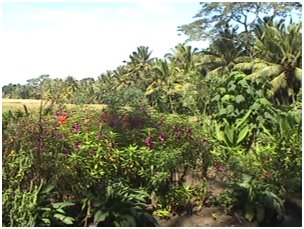All around me was the greenest green I’d ever imagined, spilling over with flowers and vines and herbs in every direction.

Bali is the lushest place I’ve ever been, with plants on top of plants, and flowers and herbs everywhere.
It was a perfect day outside – sunny and not too hot.
My guide and new friend Westi was sitting with me in a kind of covered shelter with a big brown picnic table area after our tour of his incredible herb garden.
“You were telling me about holy basil…” I said. “… and you called it…”
“Tulsi. Also sacred basil,” Westi said. Tulsi is what they called it when I saw it in India, too.
Westi told me, “We use it in tea. A lot of it. It’s good for coughs.”
Tulsi tea is easy to make, once you know how. All you need are a few leaves, dried or fresh, of the holy basil plant.
- First, heat a quart of water.
- Put in 3 heaping teaspoons of leaves.
- Let them decoct for about 5 minutes.
- Strain into a cup or glass.
In Bali, they add lemongrass for flavor. Westi says they also put ginger in their holy basil tea for added effect.
You can drink it warm, but I enjoyed my holy basil tea over ice.
Do you know about holy basil?
It’s a special type of basil that can increase your immunity, relieve pain, and is detoxifying.
Westi grows three different kinds of basil. One is lemon basil, which smells exactly like its name. A combination of lemon and basil. Another is what he calls “fragrant” basil, which he and his wife Lelir use in their beauty formulas.
But the one with the most healing properties is holy basil. And science backs up the benefits of holy
basil, which the Balinese have known for centuries.In one study on immune health, researchers took a group of people and measured their normal levels of the immune markers interferon and interleukin-4, and their normal percentage of t-helper cells and natural killer cells.
Then they gave them holy basil for four weeks and re-measured. Levels of all these immune system defenders increased significantly, especially the hardest working immune cell, the T-cell.1
Holy basil is also anti-inflammatory. It contains dozens of inflammation-reducing nutrients, including one called ursolic acid.
Ursolic acid inhibits the inflammatory COX-2 enzyme2 but without the nasty side effects of pharmaceutical drugs.
It also inhibits 5-lox, which is activated by the stress hormone cortisol. 5-lox converts arachidonic acid (a bad fat made within the body from vegetable oils) to highly inflammatory leukotrienes. Leukotrienes promote arthritis.
One animal study looked at holy basil’s pain-relieving power. An extract was about 60 percent as effective as sodium salicylate (an aspirin-related compound) in reducing inflammation.
Holy basil also has other beneficial properties. Animal studies have found that holy basil is effective against both anxiety and depression.4
Holy basil is also detoxifying. In another study, a very small amount of holy basil extract reversed toxicity from the extremely poisonous industrial metal cadmium.5
Fortunately, you don’t have to go all the way to Bali to enjoy the benefits of holy basil.
You can get the dried plant at most health-food stores, and online at mountainroseherbs.com, taoofherbs.com, and indusorganics.com.
Holy basil extracts, leaves, roots, seeds and oil may be available from online wholesalers like naturalcosmeticsupplies.com.
You can also get an extract of holy basil to take as a supplement, in either liquid or capsule form.
Gaia organics and Herb Pharm are two companies that sell the extract as a liquid. Take one dropper full two to three times a day between meals.
In a capsule, make sure the product you’re buying has at least 2.5% ursolic acid to get the anti-inflammatory effect. I recommend 150 mg three times a day, but you can take as much as 800 mg.
Or you can do what I do and make a delicious tea.
To Your Good Health,
![]()
Al Sears, MD
1. Mondal S, et. al. “Double-blinded randomized controlled trial for immunomodulatory effects of Tulsi (Ocimum sanctum Linn.) leaf extract on healthy volunteers.” J Ethnopharmacol. 2011 Jul 14;136(3):452-6.
2. Ringbom T, et al. “Ursolicacid from Plantago major, a selective inhibitor of cyclooxygenase-2 catalyzed prostaglandin biosynthesis.” J Nat Prod. 1998; 61:1212-15.
3. Godshani S, et al. “Ocimum sanctum: an experimental study evaluating its anti-inflammatory, analgesic and antipyretic activity in animals.” J Ethnopharmacol. 1987;21:153-63.
4. Chatterjee M, Verma P, Maurya R, Palit G. “Evaluation of ethanol leaf extract of Ocimum sanctum in experimental models of anxiety and depression.” Pharm Biol. 2011 May;49(5):477-83.
5. Bharavi, K, et. al. “Prevention of cadmium bioaccumulation by herbal adaptogens.” Indian J Pharmacol. 2011 February; 43(1): 45–49.

